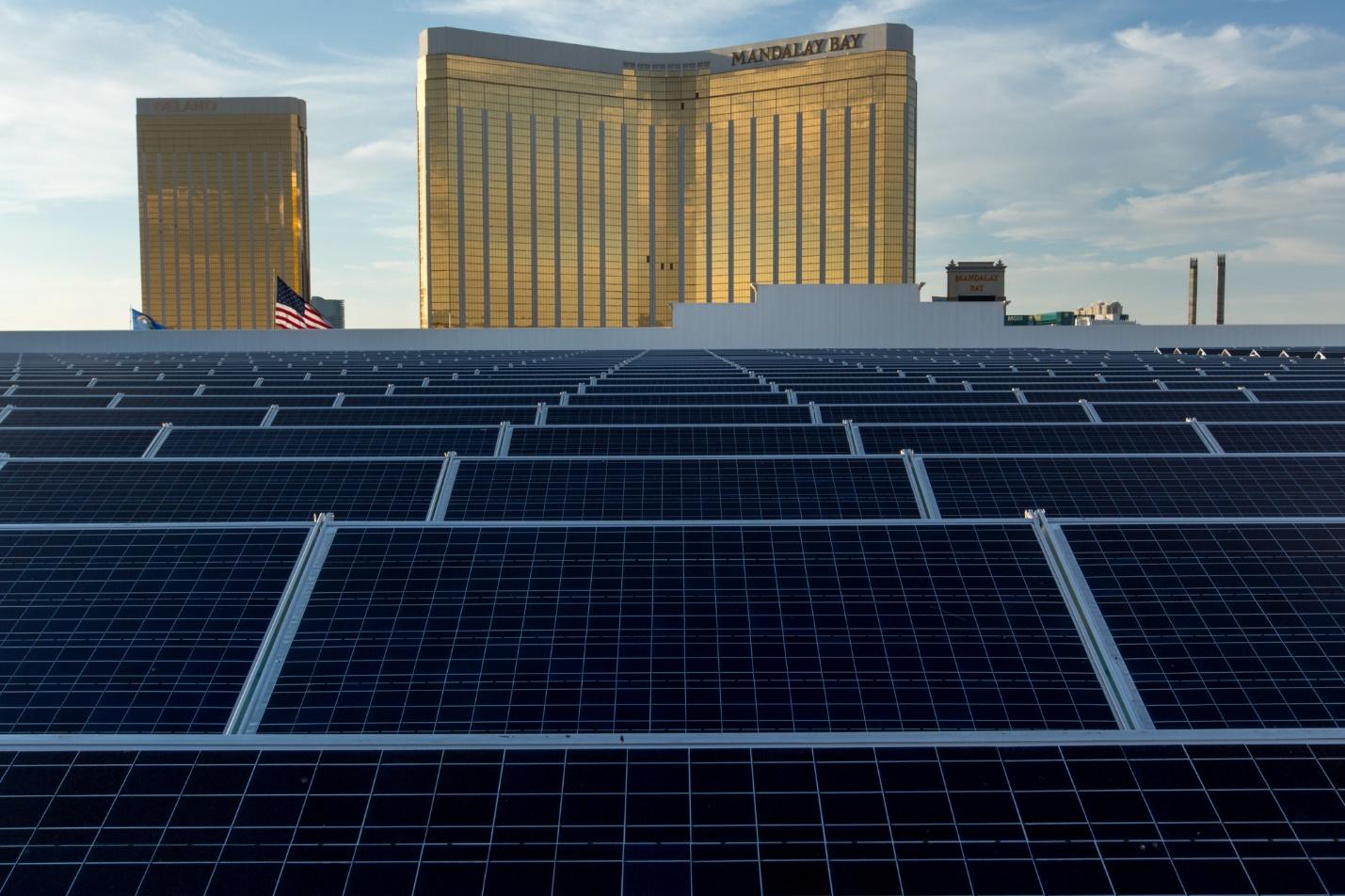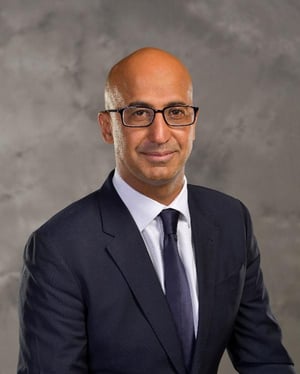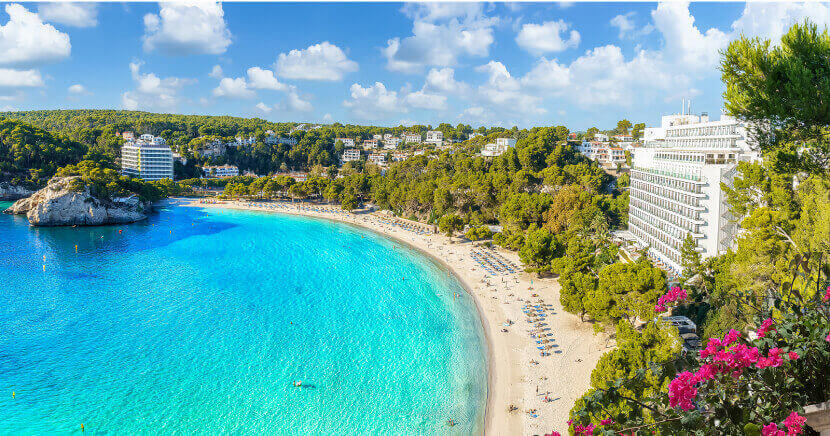An excerpt of my interview with Yalmaz Siddiqui, Vice President Corporate Sustainability, at MGM Resorts International
Check out the entire interview in The Insider magazine on PressReader
Las Vegas has been called many things over the decades, but a sustainable haven for the circular economy and waste management is probably not something you hear very often. Did you know that Las Vegas currently ranks seventh in solar energy supply per capita across the whole US, or that it has global best practices in food waste management?
It certainly was a surprise to me, even though we’ve worked with a number of Las Vegas hotels and casinos to replace printed newspaper and magazine consumption with a more sustainable digital option. ARIA and Vdara, both MGM Resorts properties, are just two examples.
In February 2020, a team from PressReader attended the Forbes Travel Guide Luxury Summit at the ARIA and was frankly blown away by ARIA’s commitment to Sustainable Development. I dug a little deeper and discovered that MGM Resorts represents about half of the Las Vegas Strip, occupying 70M square feet of buildings, 40,000 rooms, 400 restaurants, and 4M square feet of convention space. And that many of MGM Resorts’ sustainability programs are often adopted by other properties across the city. I was impressed.
I decided to reach out to the vice president of corporate sustainability at MGM Resorts, Yalmaz Siddiqui, to learn more. I hope when you read this transcript of our conversation, you’ll walk away with a new respect for this misunderstood city.
NIKOLAY MALYAROV: Thanks so much, Yalmaz, for taking the time to chat today. You have a fascinating background, notwithstanding the Canadian connection with your studies and teaching at McGill University.
You’ve been a consultant for both PricewaterhouseCoopers and IBM, worked for over a decade in different senior sustainability-focused roles at Office Depot, and have spent the last four years at MGM Resorts International as the VP of Corporate Sustainability.
Sustainability means different things for different people; what does it mean for you given your experience in so many industries?
YALMAZ SIDDIQUI: Well, I would like to start with the original definitions, and my initial steps into this space were around the time that the notion arrived in the world in 1987, with the release of Our Common Future, the book by the World Commission on Environment and Development (WCED). That definition of sustainability known as the Brundtland definition is “development than meets the needs of present generations without compromising the ability of future generations to meet their own needs.”
Then there’s the 1997 definition by John Elkington, which is about achieving the Triple Bottom Line of economic progress, social progress, and environmental progress.
My attempt to crisply define sustainability, referencing these two original definitions, is “meeting the environmental, social, and economic needs of present generations without compromising the ability of future generations to meet their own environmental, social, and economic needs.” It’s a merger of those two original definitions. I don’t try and make my own definition; I go back to the source.
NIKOLAY MALYAROV: That’s great. Having spent the last four years in the hospitality industry, which is quite a bit different from office supply retailing and other verticals you worked in, what are the most significant changes concerning sustainability you’ve seen in the industry since you first entered this space?
YALMAZ SIDDIQUI: You specifically asked about hospitality, but I think my answer applies to the corporate world in general. In the corporate world, including hospitality, there’s been a real emergence of this function of Corporate Social Responsibility (CSR) or Sustainability, from nice-to-have maybe four or five years ago to a must-have more recently.
The historic business case is that working in these areas is the right thing to do from a moral standpoint and to enhance corporate reputation. Today the moral and reputational business case is, in fact, more important because morality and reputation matters even more than in the past, especially with the rise of social media and society’s growing expectations of companies. However, there is also a growing recognition among corporate leaders that there is a financial business case to working on these matters, in terms of cost savings, risk management, and long-term revenue enhancement. So I’d say across the corporate world: sustainability has transitioned from a nice-to-have to must-have, that there has been a broadening of business case drivers, and a growing recognition that all of these drivers, including the historical ones, are increasingly important.
Finally, the functional areas historically focused on the themes covered by CSR or sustainability have been separate. There’s been a diversity team, a philanthropic team, an environmental team, all working on the notion of driving more “purpose.” These historically separate silos are all coming together now to consider how to work together to advance social and environmental good in a more cohesive and aligned way across the pillars.
In addition, I think there’s a real rise in investor focus on ESG: Environmental, Social, and Governance. Investors are genuinely interested in these topics as part of the long term management of their investments. Environmental matters have traditionally been the focus of many investors and other observers interested in sustainable investment. And while there are a lot of metrics and robust accounting for environmental matters, there’s been less of a focus on social issues in terms of the way to measure, the way to drive improvements, and the way to set goals.
Now, because of COVID and candidly, at this moment with Black Lives Matter and even the Me Too movements, I think there’s a rise of the ‘S’ – the social aspect of sustainability or ESG is really coming to the fore. Again, all of these trends apply to all Corporate sectors, and they’re equally important in hospitality.
NIKOLAY MALYAROV: This past February, one of your hotels, the ARIA Resort and Casino, hosted Verified — The Forbes Travel Guide Luxury Summit — one of the most prestigious events in the world. Every year the invite-only summit brings together all the top executives from four- and five-star hotels that adhere to the luxury standards monitored by the Forbes Travel Guide Group. Our team was there because we’ve been working with Forbes Travel Guide for several years; we’re their Official Digital Media Provider.
ARIA is one of the most beautiful hotels that I’ve been to, but it’s also one of the largest LEED [Leadership in Energy & Environmental Design] gold-certified buildings in the world. We’re seeing a rise in travelers’ recognition and patronage of businesses that support environmental initiatives, and ARIA certainly does that, especially in terms of reducing the carbon footprint of the organization.
But for MGM’s other hotels that are older and not LEED-certified, it must be challenging to reach the level of sustainability you desire. How are you addressing those challenges?
YALMAZ SIDDIQUI: ARIA is so significant to our portfolio that just the arrival of that property increased the energy efficiency and water efficiency of the whole portfolio very significantly. We learned during the 2007-2009 period when we were developing ARIA that there was something to be said for being conscious of the choices we were making in terms of energy, water, and other matters.
We learned a lot from the LEED certification process and started applying it to other buildings and historic properties created before LEED or other green building certifications existed. We looked at energy audits, energy management systems, and energy efficiency upgrades of HVAC systems and lighting. We also explored how to better manage water and materials on our existing properties.
Between 2009 when we opened ARIA and the present day, we have spent a lot of effort in significantly reducing water and energy use by converting less water-efficient faucets and appliances to more efficient ones and converting turf to artificial in our landscaping, for example.
In terms of recycling and materials management, that has happened across the board with significant investment in putting material recovery facilities behind every one of our existing Las Vegas properties, retroactively.
Then finally, certification. Certification doesn’t just exist for new buildings; there are environmental certifications for existing operations like Green Key, Green Key meetings, and Green Globes.
When looking to make an environmentally efficient building, it’s always best to start at the design phase, because a lot of the decisions that you make during design affect the long-term ability for that property to be efficient. You look at the main lessons from a new build: energy efficiency, water efficiency, and material efficiency. Then you implement good practices in your existing buildings, and you certify those existing buildings to a standard. That’s what we’ve done.
Today, the majority of our hotels are certified to an existing building or operational environmental standard like Green Key or Green Globes. In fact, over 90% of our square footage now in the world is certified to either a new building standard or an existing building standard, and that’s a commitment we’re going to continue to follow.
NIKOLAY MALYAROV: For those who haven’t been to Las Vegas, it’s a very interesting place with a very distinctive desert climate that clearly lacks water, and provides plenty of sunshine. One of the projects that you embarked on at the group was to build a solar array. How does that fit into your overall Sustainability goals? And what are you expecting in terms of the impact on sustainability?
YALMAZ SIDDIQUI: In terms of reducing your carbon footprint, the first thing to do is reduce your energy use, and that’s what we’ve done quite a lot. There’s still more opportunity for us to further increase energy efficiency, but, at some point, to reduce your carbon footprint, you can’t optimize energy anymore; you absolutely need to start procuring renewable energy. As part of that recognition, we broke ground this year on a 100-megawatt solar array; that’s the size that a regional or national utility would typically build – it has over 300,000 solar panels.

The array is currently being built by our partner, Invenergy. When it’s producing electricity next year, at peak production that hundred megawatts is going to generate about 90% of the daytime electricity needs of all our properties on the Vegas Strip, so that’s about 70,000,000 square feet (Editor’s note: 6.5 km2, which is more than three times the size of the Principality of Monaco). At peak production during a hot day, over 90% of our electricity will be provided by that array.
If you look over an entire year worldwide, about 30% of our global energy will be renewable, and one of the main drivers of that achievement is that solar array.
NIKOLAY MALYAROV: Fantastic. A few months back, MGM Resorts International announced its focus on four goals that fit the CSR aspect.
- Fostering Diversity & Inclusion
- Investing in Community
- Caring for One Another
- Protecting the Planet
All of these also tie nicely into the Triple Bottom Line that you referenced earlier: people, planet, and profit. One of the specific elements that you have spoken about before is the program that you’ve been running for several years, and that is waste management.
In your presentation, What Cooks in Vegas Stays in Vegas, you said that over the past 12 years, you have kept over 200,000 tons of food waste away from landfills and donated it. Can you tell a bit more about the program, why are you excited about it, and what’s next for it in your organization?
YALMAZ SIDDIQUI: The primary way we think about food waste is to look at food waste by type, and ask, what’s the best destination for this food waste that’s produced for whatever reason?
Our food donations program arrived when we realized that of all the food waste we were sending to various sources, including farms and composting providers, some of it was, in fact, high-quality food that could be repurposed.
So in 2016, we piloted and then scaled a process to safely rescue unserved food from large events. We then extended that program to collect and safely rescue unserved food from our kitchens and warehouses. Now, we’ve reached a milestone of over a million meals of rescued food. On top of that, there’s also the food we fund for donations. So, there are about 1.5M meals in total that we donate to charities — 1M of which is rescued from our resorts. That’s one type of food.
There’s also food that we wouldn’t be able to donate to people, whether it’s kitchen scraps or otherwise contaminated. That goes to farms as feed for livestock, pigs. There’s also a lot of yellow and brown grease generated in kitchens, the vast majority of which goes to create biofuel.
What’s next is a stronger focus on the food that is co-mingled with disposable food-and-beverage containers. We did a very thorough audit of our food waste recently. We broke open hundreds of garbage bags to get a representative sample of what food we were still sending to landfill. We observed and weighed the food and discovered that there was a lot of co-mingling of food packaging and food. So we’re going find ways to take compostable food-and-beverage containers that are co-mingled with food and diverting them properly and more extensively. That’s next on the agenda.
Las Vegas isn’t known for having expertise in food waste management. In fact, it’s reputation is quite the opposite. But the truth is, we’re one of the best places in the world in terms of managing food waste responsibly.
NIKOLAY MALYAROV: Yeah, that was certainly a discovery for me when I listened to your presentation. The part about used oyster shells being repurposed for farming of new oysters? That was truly fascinating!
You’ve touched upon compostable containers, which has obviously seen a big push around the world, trying to get away from single-use plastics and moving more towards sustainable solutions when it comes to food packaging.
But then came the events over the past three or four months. COVID has changed our lives significantly, including single-use plastic bags reappearing back at supermarkets where reusable totes are now restricted. More broadly, the pandemic has affected the travel and tourism industry at a massive scale, bringing it to a screeching halt.
Las Vegas is now reopening, and I read somewhere today that there are queues at casinos. I think with people cooped up in their houses for the last couple of months, they’re eager to start getting back to some sort of a level of normalcy.
But there will be long-lasting effects of COVID that will be felt by all of us and will impact many of the sustainable development goals, not just environmental sustainability. How are you adjusting your sustainable development objectives for next and subsequent years? What are you potentially introducing as you reflect on the effects of the pandemic?
YALMAZ SIDDIQUI: I think the effect of the pandemic is to accelerate our commitment to ESG in general, with an even stronger focus on the ‘S’ part — the social part — because of COVID and the racial justice awakening. We’ve been committed to fostering diversity and inclusion for a long time, and that’s going to accelerate. There’s long been a concern about security, and certainly, safety is now at the fore.
From an environmental standpoint, increased recognition of climate-related risks. People have been talking about climate-related risks for a while, but COVID has accelerated the recognition that external events can really disrupt supply chains. This time it was a pandemic, climate-related risks can also result in major supply chain disruptions. So I think overall, at a macro level, there will be no deviation or slowdown of the macro Sustainability agenda for the company.
In specific areas, and you referenced plastics, we need to look at this issue in a more segmented, niche way. Safety’s a dominant concern now, so the use of single-use gloves and single-use cups and things like that is likely needed going forward.
But there’s a wide range of plastics that we could consider, and some alternatives to single-use plastics are viable without bumping up against safety concerns. By using paper cups, even for hot beverages, we can move away from single-use plastics, and yet still offer single-use paper that is less problematic from an ocean and river littering perspective. We can continue looking at that.
Plastics are pervasive in the world as you know, and it’s a long-term journey to seek alternatives while not bumping up against guest and employee safety concerns that are very much at the front of everyone’s mind at the moment.
NIKOLAY MALYAROV: Last question for you. Not everybody is fortunate enough to work in an organization that embraces sustainable development like MGM Resorts.
If you were to give a piece of advice to other organizations that are just embarking on becoming more sustainable or making Sustainable Development Goals a core part of their operations, what would that advice be? How should they deal with potential objections?
YALMAZ SIDDIQUI: Let me start with what worked. What worked for me, both at Office Depot and I’d say MGM, where I held my two senior sustainability roles, is stakeholder interest. At Office Depot and, candidly, at MGM, I leveraged the fact that many large organizations that were buyers of our goods and services were interested in these topics. While they might not source from a company explicitly because the company has a good Sustainability program, they increasingly consider it part of a good quality supplier relationship.
Using stakeholder interest and leveraging that interest to engage executives has been the number one tool that I’ve had in my toolkit. Figuring out how to get the voice of the customer, or the voice of the employee or the voice of the investor even into the dialogue with senior management or functional leaders has been central to my success over the years.
I mentioned the investor, partly because historically, the investor community hasn’t vocally focused on these areas, but it really is now. In the future, the investor community is going to be the primary driver, in my opinion, of accelerating company efforts in these areas. That’s because there’s a real recognition that companies that manage ESG — Environmental, Social, and Governance — well are good companies overall, with quality management that is attuned to the way the world is moving.
That’s the piece of advice I’d offer to anyone attempting to make their sustainability programs more robust. Understand your key stakeholders, and assuming you find that many of them or the important ones are interested, leverage that interest to help nudge your organization in the direction you want.
NIKOLAY MALYAROV: Fantastic! Well, thank you so very much for your time, insights, and advice, Yalmaz. Congratulations on what you’ve achieved to date. I wish you continued good health and success, and I look forward to staying in one of your properties again when I’m down in Vegas. Stay safe!
YALMAZ SIDDIQUI: We look forward to that, Nikolay, and thank you.
About Yalmaz Siddiqui
Yalmaz Siddiqui is Vice President, Corporate Sustainability at MGM Resorts International. He helps lead the company’s Environmental, Social & Governance (ESG) disclosure, including improving transparency on a defined list of material issues and metrics and improving scoring on a prioritized set of external ESG ratings. In addition, Yalmaz oversees MGM’s Environmental Management Program and helps operationalize several specific initiatives, including sustainable events, sustainable purchasing, food waste, and circular economy.
Prior to MGM, Yalmaz was Senior Director, Sustainability at Office Depot, where he set strategy and led many industry-leading social and environmental programs. He helped the company reduce absolute carbon emissions by 40%, grow sales of environmentally preferable products from $1.2B to $3.2B, and reach a ranking of #1 greenest large retailer in America in Newsweek’s green rankings, for three consecutive years.
Before Office Depot, Yalmaz was a management consultant at PwC and IBM Consulting, where he focused on business-to-business customer strategy and operational performance improvement.
A global expert in sustainable purchasing, Yalmaz was the Founding Chair of the Sustainable Purchasing Leadership Council. He also serves on the Board of ReFED, a leading non-profit focused on using data and insights to reduce food waste in America.
Yalmaz has a Bachelor of Commerce from McGill University in Canada and a Master of Philosophy in Environment & Development from the University of Cambridge in England.
*All photos were courtesy of MGM Resorts International.








